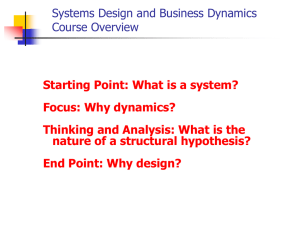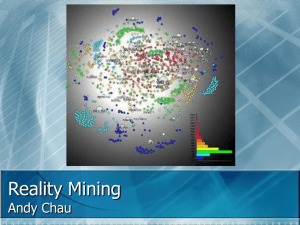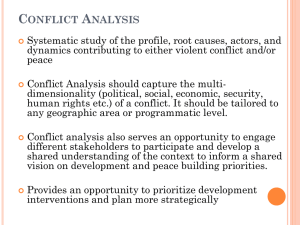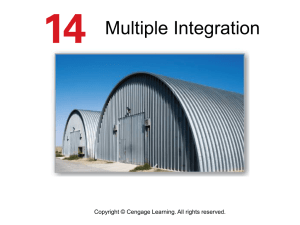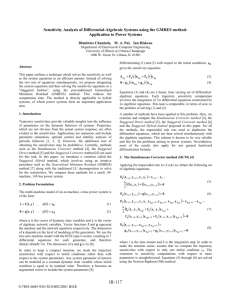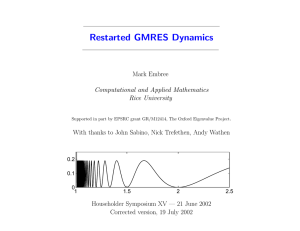here
advertisement
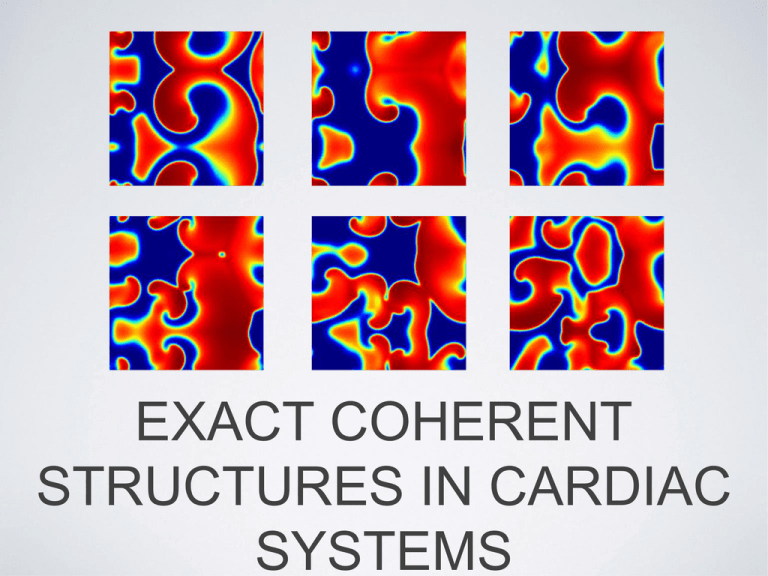
EXACT COHERENT STRUCTURES IN CARDIAC SYSTEMS THE HEART • Complicated geometries • orientation, dimensionality, anisotropy, defects • Electrical dynamics • Fluid dynamics • Shen, H. W., & Pang, A. (2007). Anisotropy based seeding for hyperstreamline. Mechanical dynamics Biomedical Physics at MPI for Dynamics and Self-Organization http://www.bmp.ds.mpg.de/imaging-electro-mechanicalwaves.html THE HEART PROBLEM • pulse waves • spiral waves • turbulence Experiment and simulation: F. Fenton, E. Cherry thevirtualheart.org Can we understand these dynamics to control the system? MONODOMAIN • Effective field equation • • Averages over the inside, membrane, and immediate outside of cardiac cells Easy to analyze • Dynamics are weakly effected by geometry BIDOMAIN • Solve voltage over membrane, intracellular, and extracellular domains • Anisotropy effects are irreducible • Additional Poisson solve I don't solve bidomain field equations See Alessandro Veneziani at Emory Math IONIC CURRENT MODELING • Karma (2, 7) • Simitev-Biktashev (3, 14) • Bueno-Orovio–Cherry– Fenton (4, 28) • Beeler-Reuter (8, ??) • Iyer et al (67, ??) F. Fenton & E. Cherry: http://www.scholarpedia.org/article/Models_of_cardiac_cell IONIC CURRENT MODELING • Karma (2, 7) • Simitev-Biktashev (3, 14) • Bueno-Orovio–Cherry– Fenton (4, 28) • Beeler-Reuter (8, ??) • Iyer et al (67, ??) • Different regions of the heart have different properties and yield different qualitative dynamics • No Navier-Stokes equations for cellular action potential KARMA MODEL • Convective instability due to alternans • • wavelength modulation Minimal restitution length http://www.ibiblio.org/e-notes/html5/karma.html BUENO-OROVIO–CHERRY– FENTON • Reproduces qualitative dynamics from more complicated models • Reproduces dynamics from experimental data http://www.ibiblio.org/e-notes/html5/bcf.html • Flexible • Simple – three ionic currents We pay for realism with obfuscation through generality THE HEART SOLUTION (On the CPU) • Operator-Splitting • Strang (ABA), O(Δt²) • Semi-Implicit • Large time-steps • Fourier basis, O(exp(1/Δx)) • Easy (spatial) derivatives • Clever flipping restricts to odd/even modes, transforms scale well: Nlog(N) • periodic, zero-field, or zero-derivative boundary conditions STRANG-SPLITTING • Most convergent operator-splitting method, without an a priori commutator [A, B] • Solve the pieces where they're best solved • Stitch it together THE HEART SOLUTION (On the GPU) • No operator-splitting • Evaluate entire RHS • Fully explicit RK4 O(Δt³) • Smaller stability window • Stencil approximations • Rotational symmetry O(Δx⁴) But it is fast THE GPU • Discretization of space into threads • Local terms (nondifferential) are easy • Nonlocal terms (differential) are hard • • memory access patterns • register usage • local memory size Potential efficiency improvements for operator splitting methods NVIDIA CUDA Programming Guide version 3.0 CC-BY-SA-3.0 THE GPU • Segmenting the space breaks synchronization • Some effort to restore it • Compute the nonlinear update and the diffusion separately • Apply them together •Diffusion is computed by finitedifference stencil and stored apart from the state •time-update by Runge-Kutta COHERENT STRUCTURES • Generic chaotic trajectory visits the vicinity of unstable coherent structures • Build a map of phase space from the invariant structures • Know where the states are to know where to push them RECURRENCE The “wait and see" method Integrate the system for a long time and look for large-scale recurrent structures. … and some time later… These nearly recurrent states serve as initial conditions for GMRES GMRES • • Generalized Minimal Residual With an initial perturbation • iteratively build a basis • and an approximate Jacobian in that basis • to compute the correction to the initial guess Newton-Krylov (JFNK) • • • It's Newton, in Krylov Solve small linear system instead of large nonlinear one GMRES • Find unstable structures with Newton-Raphson methods • The Jacobian is huge • • N=128 ⇒ 20.25 GByte* • N=512 ⇒ 1 TByte* Avoid forming the Jacobian explicitly * Assumes optimal structure using Arnoldi method for two-variable system ARNOLDI ALGORITHM • Builds an orthonormal basis which spans the least contracting subspace • Builds a small, approximate, and useful Jacobian • Relies only on forward-time integration, and some linear algebra PERIODIC ORBITS • State (u,v) maps back to (u,v) after some time T • Dynamically or time invariant • At least one marginal mode • • Jacobian is uninvertible Other marginal modes? E.T. Shea-Brown, http://www.scholarpedia.org/article/Periodic_orbit SYMMETRIES • • Constraint equations in the GMRES system • translations in x, y • rotations are harder Windowing suppresses boundary effects • Effective norm RESULTS • We got two*! • single pulse wave • • relative equilibrium single spiral core • relative equilibrium? *Families of un-/stable solutions JUST TWO? • Multi-core states present difficulties • Exponentially weak forcing • Local gauge invariance • local effects of global symmetries • this is hard to deal with WELL NOW WHAT • Symmetry reduction for a single core • Barkley, Biktashev • Co-moving frame • small set of ODE's which describes the dynamics of a single core PATHS TOWARD PROGRESS • Cores by reduction • • • reduced ODE systems with core-core coupling Why periodic orbits? • Multi-core ⇒ multi-phase •quasi-periodic networked nonlinear oscillators • Is the PDE even reducible to cores? • Vorticity formulation? •n-core • orbits? ⇒ n-tori? Try to balance complexity and non-triviality STATE OF THE PROGRAM • Efficient solvers • Numerical integration • Newton-Krylov iteration • Dominant unstable regular solutions • Traveling waves (relative equilibria) • Periodic solutions • Relative periodic solutions • Phase space topology ? Dynamical connections • Reduced order model of dynamics ? Low-dimensional linear maps in Krylov subspaces • Feedback control ? Local ? Global



